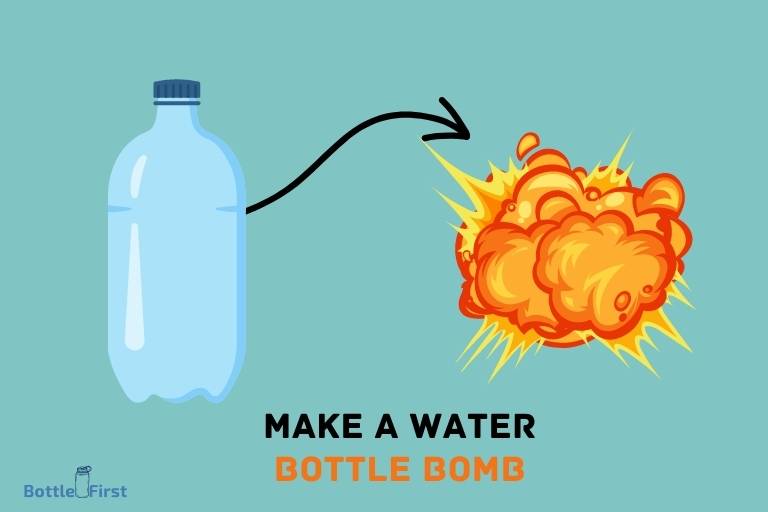How to Make a Water Bottle Bomb? Step-By-Step Guide!
Making a water bottle bomb can be a risky yet exciting experiment, especially when executed with proper precautions.
The process involves basic materials such as a plastic water bottle, baking soda, and vinegar.
However, it’s important to note that this experiment should be performed under adult supervision and in an open space to ensure safety.
A water bottle bomb works on the principle of gas expansion. When baking soda and vinegar are mixed, it creates a carbon dioxide gas that starts to expand within the bottle.
Eventually, the pressure from the gas causes the bottle to burst or explode, demonstrating a simple form of a chemical reaction.
While it can be intriguing to make a water bottle bomb, it’s crucial to prioritize safety. Always make sure an adult is present during the experiment and it is conducted in an open, unpopulated area.
Additionally, be aware that improper handling can cause injury. This experiment is intended for educational purposes, demonstrating chemical reactions, and is not meant for any harmful intentions.
Please note that this experiment must be done responsibly, taking into account the associated risks.
It should only be performed by or under the supervision of adults, and is for educational purposes only. Making these bombs for malintent or to harm others is illegal and dangerous.
Key Takeaway
Safety Precautions
When it comes to making a water bottle bomb, safety should be your utmost priority. Taking the necessary precautions not only protects you but also ensures that there is no harm to anyone or any property in the vicinity.
Before attempting to create a water bottle bomb, keep these safety measures in mind:
Wearing Protective Gear:
- Use safety goggles: Protect your eyes from any potential debris or chemical splashes that may occur during the process.
- Wear gloves: Ensure your hands are protected by wearing gloves that are resistant to chemicals or any harmful substances you may come in contact with.
- Cover your mouth and nose: By wearing a face mask or covering, you can prevent inhaling any toxic fumes or particles.
Setting Up In A Secure Location Away From People And Property:
- Choose a secluded area: Select a location where there are no nearby people, buildings, or property that could be potentially harmed in case of an accidental explosion.
- Avoid confined spaces: Opt for an open outdoor area where the blast’s impact can be minimized.
- Keep pets and children away: Ensure that no one else, especially children or animals, is in or around the designated area.
Remember, making a water bottle bomb is extremely dangerous and illegal. This information is provided solely for educational purposes.
It is strongly advised to refrain from engaging in such activities as they can result in severe injuries or legal consequences. Always prioritize safety and follow legal guidelines.
Materials Needed
When it comes to making a water bottle bomb, it’s essential to gather all the necessary materials beforehand. This section will guide you through what you’ll need and where to find them.
Remember, safety is of utmost importance when handling these materials, so make sure to take caution at all times.
Here are the key points to consider when collecting the required materials:
- Water bottle: Any standard plastic water bottle with a tight-fitting cap will suffice. Ensure that the bottle is clean and free from any liquid or residue to avoid unwanted chemical reactions.
- Vinegar: You can find vinegar in most grocery stores or supermarkets. Look for it in the condiment aisle or near other cooking ingredients.
- Safety: Despite being a common household item, vinegar should still be handled with care. Avoid direct contact with your skin or eyes. In case of accidental exposure, rinse the affected area thoroughly with water.
- Baking soda: This can be easily found in the baking section of your local grocery store.
- Safety: Although baking soda is generally safe to handle, it is always wise to wear gloves when working with any substances to prevent skin irritation or allergies.
- Aluminum foil: You can buy aluminum foil from grocery stores or convenience stores, often located in the food storage or kitchen supplies aisle.
- Safety: There are no specific safety concerns related to aluminum foil. However, be cautious when handling sharp edges if tearing off pieces from a larger roll.
- Tissue or paper towels: These can be acquired from almost any nearby supermarket, grocery store, or convenience store.
- Safety: No safety considerations are necessary for tissue or paper towels. However, use them wisely and dispose of them properly after use to maintain cleanliness.
- Safety goggles and gloves: You may need to visit a hardware store or online retailer to purchase safety goggles and gloves. Look for protective gear designed for chemical handling or general use.
- Safety: Always prioritize your safety. Wear safety goggles and gloves to protect your eyes and hands from potential hazards during the process.
Remember to adhere to all safety precautions mentioned and follow local regulations regarding the creation or use of water bottle bombs. Safety should always be your top priority.
Step-By-Step Instructions
Preparing the water bottle:
- Ensure that you have a clean and empty plastic water bottle. Make sure there are no cracks or leaks in the bottle.
- Remove the label and any remaining adhesive from the bottle, as it may interfere with the bomb’s effectiveness.
- Rinse the bottle thoroughly with water to remove any residue or impurities.
Choosing the right size and shape:
- Opt for a standard-sized water bottle, typically 16 to 20 ounces, as a larger bottle might pose safety risks.
- Choose a bottle with a cylindrical shape rather than an irregular one, as it will be easier to handle and control during the activation process.
Creating a secure seal:
- After filling the bottle with the necessary ingredients, screw the cap on tightly to ensure it seals securely.
- Check for any gaps between the cap and the bottle; if there are any, adjust the cap until you achieve a snug fit.
- Avoid overfilling the bottle, as it may cause pressure to build up and increase the risk of explosion.
Adding the ingredients:
- Decide on the type of ingredients you want to use for your water bottle bomb. Common choices include baking soda and vinegar, or mentos and soda.
- If using baking soda and vinegar, pour vinegar into the bottle first, filling it about 1/3 of the way. Then add a spoonful of baking soda and quickly secure the cap.
- Alternatively, if using mentos and soda, drop a few mentos into the bottle, quickly screw on the cap, and shake the bottle gently to distribute the mentos evenly.
Discussing different options and their effects:
- Baking soda and vinegar create a chemical reaction that releases carbon dioxide gas, resulting in pressure buildup within the bottle.
- Mentos and soda, on the other hand, trigger a rapid release of carbon dioxide gas due to the catalytic properties of the mentos, leading to a quick and explosive reaction.
Measuring the right amounts:
- For the baking soda and vinegar option, use approximately 1/3 cup of vinegar and one spoonful of baking soda.
- When using mentos and soda, two to three mentos should be sufficient to produce a significant reaction.
Activating the bomb:
- Once the ingredients are added and the bottle is sealed, place the bomb on a flat surface and stand back to ensure your safety.
- Consider wearing safety goggles and gloves to protect yourself from any potential splattering or debris during activation.
- Never shake or puncture the bottle after activating the bomb.
Ways to initiate the reaction:
- To activate the reaction for the baking soda and vinegar option, simply invert the bottle, which will allow the vinegar to mix with the baking soda, creating a chemical reaction.
- With the mentos and soda option, swiftly remove the cap or loosen it slightly to release the mentos into the soda, triggering the reaction.
Safety precautions during the activation process:
- Keep a safe distance from the bomb after activating it to avoid any potential harm.
- Do not lean over the bottle or place any body parts directly above it when initiating the reaction.
- Never throw or aim the bomb at people, animals, or objects, as it can cause injury or damage.
Remember, while making a water bottle bomb might seem exciting, it is crucial to prioritize safety at all times.
Educate yourself about the potential risks and ensure that you are in a controlled environment when experimenting with these explosive reactions.
Safety Considerations And Consequences
Water bottle bombs may seem like a harmless experiment or prank, but they can have severe consequences.
It is important to understand the potential harms and damages caused by these devices, as well as the legal consequences of creating and using them.
Let’s dive into the safety considerations and consequences associated with water bottle bombs.
Discussing The Potential Harms And Damages Caused By Water Bottle Bombs
Creating and using water bottle bombs can lead to serious injuries and damages.
Here are some key points to consider:
- Instability: Water bottle bombs are inherently unstable due to the chemical reactions they rely on. Unpredictable detonations can cause harm not only to the person handling the device but also to innocent bystanders.
- Shrapnel: The explosion of a water bottle bomb can propel sharp pieces of plastic and other fragments at high speeds. These projectiles can cause severe lacerations and eye injuries.
- Fire hazards: Water bottle bombs often employ flammable materials, such as fuels or accelerants. Ignition of these substances can result in unintentional fires, causing property damage and endangering lives.
- Environmental impact: The remnants of water bottle bombs, including chemicals and plastic debris, can contaminate the environment. This poses a threat to wildlife and ecosystems.
Highlighting The Legal Consequences Of Creating And Using Them
Making and using water bottle bombs is not only dangerous but also illegal.
Here are some important legal considerations:
- Criminal charges: Creating and using explosive devices, even simple ones like water bottle bombs, is a criminal offense in many jurisdictions. Depending on the severity of the case, individuals involved may face charges such as possession of explosive materials, endangerment, or even terrorism-related offenses.
- Property damage liability: If a water bottle bomb causes damage to property, the person responsible can be held liable for the costs of repairs or replacement. This can result in significant financial burdens.
- Legal records: Involvement in any illegal activity, including the creation and use of water bottle bombs, can result in a criminal record. This record can have long-lasting consequences, affecting employment opportunities, educational pursuits, and personal reputation.
Understanding the potential harms and legal repercussions associated with water bottle bombs is crucial.
It is vital to prioritize safety, respect the law, and seek more positive and responsible ways to have fun or experiment without endangering oneself or others.
Stay safe and make wise choices!
FAQ About How To Make A Water Bottle Bomb
How Do You Make A Water Bottle Bomb?
To make a water bottle bomb, combine baking soda, vinegar, and water in a sealed bottle and wait for the pressure to build.
Can A Water Bottle Bomb Explode?
Yes, a water bottle bomb can explode due to the pressure buildup from the chemical reaction inside the bottle.
Is Making A Water Bottle Bomb Illegal?
Yes, making a water bottle bomb is illegal as it is considered a dangerous explosive device.
What Are The Dangers Of A Water Bottle Bomb?
Water bottle bombs can cause severe injuries, burns, property damage, and pose a significant risk to human safety.
How Can I Stay Safe From Water Bottle Bombs?
To stay safe from water bottle bombs, educate yourself about their dangers, avoid handling suspicious bottles, and report any suspicious activity to the authorities.
Conclusion
It is important to prioritize safety and responsibility when it comes to experimenting with homemade devices like water bottle bombs.
While the creation of such devices may seem intriguing or enticing, it is crucial to understand the potentially dangerous consequences they can have.
The explosive nature of these bombs poses a significant risk not only to the individuals creating them but also to innocent bystanders and property.
It is essential to remember that engaging in these activities is not only illegal but also extremely hazardous.
Instead, it is advisable to explore safer and more responsible hobbies that can still provide excitement and knowledge.
Consider pursuing interests such as science experiments, outdoor activities, or creative endeavors that offer a balance between enjoyment and safety.
By making informed choices, we can protect ourselves, our loved ones, and the community at large.







